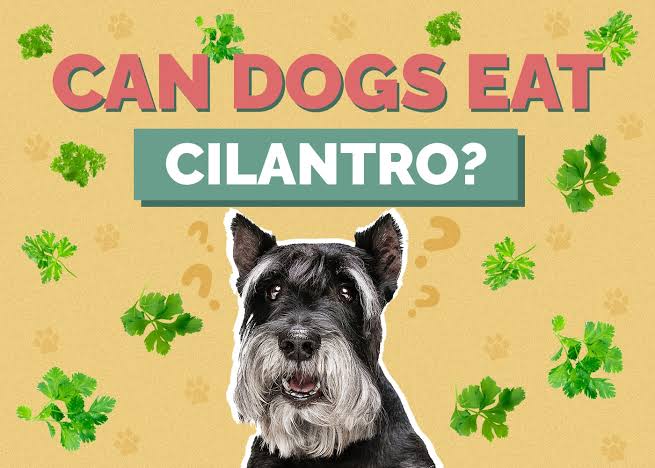The purpose of this article is to explore whether cilantro is safe for dogs to consume and any potential benefits or risks associated with it. Hence, the question “Can Dogs Eat Cilantro?”. Other subtopics we shall discuss are: Importance Of Safe And Nutritious Diet For Dogs, Nutritional Benefits Of Cilantro For Dogs, Incorporating Cilantro Into Your Dog’s Diet, Potential Risks And Considerations Of Cilantro To Dogs, etc.
When it comes to our furry friends, ensuring their diet is safe and healthy is a top priority. As pet owners, we often wonder about the foods we enjoy ourselves and whether they are safe for our canine companions. Cilantro, a flavorful herb commonly used in many culinary dishes, is one such food that raises questions among dog owners.
See Also: Bark Collar For Large Dogs

Importance Of Safe And Nutritious Diet For Dogs
A diet consisting of high-quality ingredients provides essential nutrients that support your dog’s overall health, including their immune system, coat, skin, and energy levels. A balanced diet can help prevent nutritional deficiencies and promote vitality and longevity.
On the other hand, feeding your dog a nutritious diet can help reduce the risk of various health conditions, including obesity, diabetes, heart disease, and certain cancers. A diet rich in antioxidants, vitamins, and minerals supports your dog’s immune system, helping them fight off infections and illnesses more effectively.
Furthermore, obesity is a common health issue among dogs and can lead to a myriad of health problems, such as joint issues, respiratory difficulties, and a shortened lifespan. Providing your dog with portion-controlled, nutritionally balanced meals can help maintain a healthy weight and prevent obesity-related complications.
Last but not the least, a diet that is easily digestible and free from fillers, artificial additives, and unnecessary fillers promotes optimal digestive health in dogs. High-quality ingredients, such as lean proteins, whole grains, and fiber-rich vegetables, support gastrointestinal function and help prevent digestive upset.
Can Dogs Eat Cilantro?
Yes, dogs can eat cilantro in moderation. Cilantro, also known as coriander, is non-toxic to dogs and can be safely included in their diet. However, it’s essential to introduce cilantro gradually and in small amounts to monitor for any adverse reactions.
Nutritional Benefits Of Cilantro For Dogs
Cilantro is more than just a tasty herb for humans; it can also offer some nutritional benefits for our furry friends. Here’s a closer look at why cilantro can be a healthy addition to your dog’s diet:
Vitamins And Minerals
Cilantro is packed with essential vitamins and minerals that can support your dog’s overall health. It contains vitamins A, C, and K, which are important for maintaining vision, supporting the immune system, and promoting proper blood clotting.
Antioxidants
Cilantro is rich in antioxidants, such as beta-carotene and lutein, which help protect your dog’s cells from damage caused by harmful molecules called free radicals. Antioxidants can also help reduce inflammation and support cardiovascular health.
Digestive Health
The fiber content in cilantro can aid in digestion and promote gastrointestinal health in dogs. Additionally, cilantro contains natural enzymes that may assist in the breakdown of food, making it easier for your dog to digest their meals.
Freshens Breath
Cilantro contains natural compounds that can help freshen your dog’s breath. Chewing on cilantro leaves can help remove food particles and bacteria from your dog’s mouth, reducing the risk of bad breath.
Immune Support
The vitamins and antioxidants found in cilantro can help support your dog’s immune system, making them better equipped to fight off infections and illnesses. A strong immune system is essential for maintaining your dog’s overall health and well-being.
See Also: Food Aggression In Dogs
Incorporating Cilantro Into Your Dog’s Diet
There are several ways to incorporate cilantro into your dog’s diet. You can chop up fresh cilantro leaves and mix them into your dog’s regular meals as a tasty and nutritious addition. Alternatively, you can blend cilantro into homemade dog treats or sprinkle it on top of their food as a garnish.
When introducing cilantro to your dog’s diet for the first time, start with small amounts to ensure they don’t have any adverse reactions. Monitor your dog closely for signs of allergic reactions or digestive upset. If your dog tolerates cilantro well, you can gradually increase the amount you feed them.
Overall, cilantro can be a healthy and flavorful addition to your dog’s diet, providing them with essential nutrients, antioxidants, and digestive support. Just remember to use it in moderation and consult with your veterinarian if you have any concerns about feeding cilantro to your dog.

Potential Risks And Considerations Of Cilantro To Dogs
While cilantro can offer nutritional benefits for dogs, it’s essential to be aware of potential risks and considerations before adding it to your furry friend’s diet. Here are some important points to keep in mind:
1. Allergic Reactions:
Just like humans, dogs can have allergies to certain foods, including cilantro. While allergic reactions to cilantro are rare in dogs, they can still occur. Symptoms of an allergic reaction may include itching, redness, swelling, vomiting, or diarrhea. If you notice any of these symptoms after feeding your dog cilantro, discontinue feeding it immediately and consult your veterinarian.
2. Digestive Sensitivity:
Introducing new foods into your dog’s diet can sometimes lead to digestive upset, such as diarrhea or vomiting. While cilantro is generally considered safe for dogs, some dogs may have a sensitive stomach and may not tolerate it well. Start by feeding your dog small amounts of cilantro and monitor their reaction closely. If digestive issues persist, it may be best to avoid feeding cilantro to your dog.
3. Oxalate Content:
Cilantro contains oxalates, which are compounds that can contribute to the formation of kidney stones in susceptible dogs. While the oxalate content in cilantro is relatively low compared to other foods, feeding large quantities of cilantro to your dog may increase their risk of developing kidney stones over time. It’s essential to feed cilantro in moderation and consult with your veterinarian if you have concerns about your dog’s kidney health.
4. Pesticide Residues:
As with any fresh produce, cilantro may contain pesticide residues if not properly washed or sourced from organic sources. Pesticide residues can be harmful to your dog’s health if ingested in large amounts. To minimize the risk, always wash cilantro thoroughly before feeding it to your dog, and consider choosing organic cilantro whenever possible.
5. Individual Sensitivities:
While cilantro may be safe for the majority of dogs, it’s essential to pay attention to your dog’s individual response to it. If you notice any unusual symptoms or changes in behavior after feeding your dog cilantro, consult with your veterinarian for personalized advice.

Is Organic Cilantro Safer For Dogs?
Organic cilantro can be a safer choice for dogs due to reduced pesticide exposure and environmental benefits associated with organic farming practices. However, both organic and conventionally grown cilantro can be part of a balanced diet for your furry friend, provided it is fed in moderation and prepared properly. As always, consult with your veterinarian for personalized dietary advice tailored to your dog’s specific needs and preferences.
See Also: Are Hydrangeas Toxic to Dogs
FAQs About Dogs Eating Cilantro
Is Cilantro Safe For Dogs To Eat?
Yes, cilantro is generally safe for dogs to eat in moderation. However, it’s essential to monitor your dog for any adverse reactions, especially if they are trying it for the first time.
Can Cilantro Be Beneficial For Dogs?
Cilantro can offer some nutritional benefits for dogs, including vitamins, antioxidants, and digestive support.
What Are The Potential Risks Expected From Feeding Cilantro To Dogs?
While cilantro is safe for most dogs, there are potential risks to consider, such as allergic reactions, digestive sensitivity, and the oxalate content, which may contribute to kidney stone formation in susceptible dogs.
How Much Cilantro Can I Feed My Dog?
It’s best to start with small amounts of cilantro and monitor your dog’s reaction. If they tolerate it well, you can gradually increase the amount, but always feed cilantro in moderation as part of a balanced diet.
How Should I Prepare Cilantro For My Dog?
Wash cilantro thoroughly to remove any dirt or contaminants before chopping it into small, manageable pieces. You can mix chopped cilantro into your dog’s food or use it as a garnish.
Can Cilantro Help With My Dog’s Bad Breath?
Cilantro contains natural compounds that can help freshen your dog’s breath by removing bacteria and food particles from their mouth. However, it’s essential to address the underlying cause of bad breath, such as dental issues or poor oral hygiene.
Conclusion
The question of whether dogs can eat cilantro has been thoroughly explored, and the answer is yes, they can, but with some considerations. Cilantro can offer nutritional benefits for dogs, including vitamins, antioxidants, and digestive support.
However, it’s essential to be mindful of potential risks such as allergic reactions, digestive sensitivity, and the oxalate content. They may contribute to kidney stone formation in certain dogs.
When feeding cilantro to your dog, start with small amounts and monitor their reaction closely. If they tolerate it well, you can incorporate it into their diet in moderation as part of a balanced meal. Additionally, always wash cilantro thoroughly and prepare it properly before feeding it to your dog.

